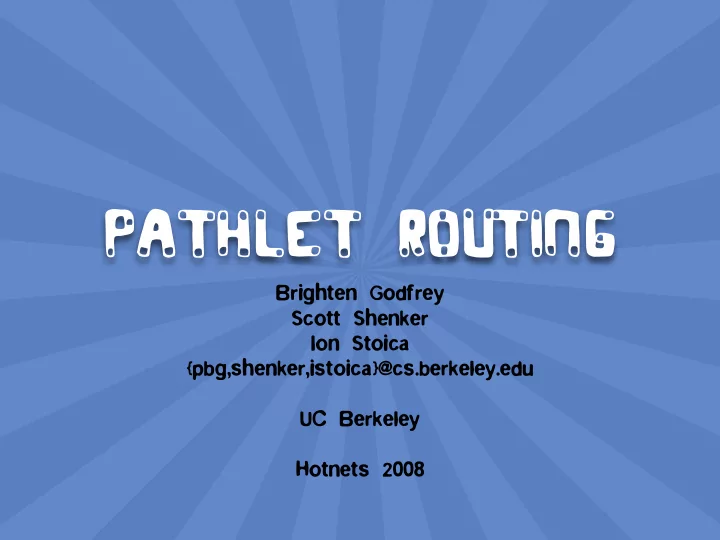

Pathlet Routing Brighten Godfrey Scott Shenker Ion Stoica {pbg,shenker,istoica}@cs.berkeley.edu UC Berkeley Hotnets 2008
multipath internet routing good for everyone! reliability source observes directly, reacts quickly path quality source observes directly, knows what it wants money network providers can sell new service
good for everyone “The Route Not Taken” [Frost 1920] Two routes diverged in a network, and I -- I took the one less transited, And that has reduced latency by up to 41%.
why don’t we have it? Even if everyone involved wants multipath, no way to do it in BGP! All paths blocked except one. Offer more? State explosion!
why don’t we have it? AS-level source routing... c a b d b,c,d ...gives network owners no control.
why don’t we have it? path vector (BGP) AS-level source routing great at blocking paths! great at allowing paths! bad at allowing them. bad at blocking them. Highly constrained routing policies. flexible many goal: policy control paths
pathlet routing fragments of paths + source routing (pathlets) flexible many goal: policy control paths
outline • the protocol • emulating other protocols • local transit (LT) policies
pathlet routing example 1. vnode: virtual node one per AS within an AS a 2. pathlet: sequence one per link b of vnodes c gossip all 3. announce pathlets d known pathlets to neighbors 128.2.0.0/16 4. source lists pathlets in packet = AS level source routing
forwarding plane 1,2,2 • pathlets tagged with a Forwarding ID 1 1 sequence 2,2 • packet contains list b 1 2 of FIDs c 3 1 2 • forwarding table 2 2 d maps FID to, e.g., 128.2.0.0/16 outgoing interface
outline • the protocol • emulating other protocols • local transit (LT) policies
emulating BGP a 1,7,1 1,7,1 b 7,1 c 7,1 (not discussed: how to verify d 1 1 1 route follows advertised policy) 128.2.0.0/16
emulating other protocols • MIRO [Xu, Rexford, SIGCOMM’06] • NIRA [Yang, Clark, Berger, ToN’07]
outline • the protocol • emulating other protocols • local transit (LT) policies
“local transit” policies Each ingress --> egress pair is either allowed or disallowed. Subject to this, any path allowed!
LTP a common case? • capture a network’s direct costs • valley freeness is a LT policy, and the common case in BGP export policies today
valley free routing as an LTP “customers can route to anyone; anyone can route to customers” providers peers customers
scalability Pathlet routing, BGP class-based LT policies forwarding O(kn) O(d+k) table entries control plane O(dkn) O((d+k)n) entries control plane > O(Lkn/d) O(dn) messaging n = # ASes d = mean # neighbors L = mean path len k = prefixes per AS
forwarding table entries current Internet (CAIDA/APNIC): BGP one per destination 266,073 entries (IP prefix) pathlet routing, one for each pathlet 2,317 entries, max LT policies starting at the router 6 entries, mean
conclusion • pathlet routing: flexible policies --> multipath with many choices, better scalability • can’t emulate everything, e.g. FBR [Zhu, Gritter, Cheriton ‘03] • emulate others? path splicing [Motiwala, Elmore, Feamster, Vempala 2008] , Routing Deflections [Yang, Wetherall 2006] • challenge for all multipath protocols: different payment for different paths? thanks: fonts by tom7
Recommend
More recommend